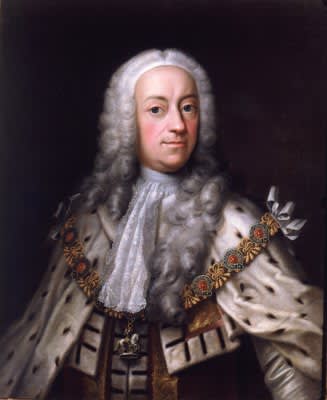
Barthelemy du Pan
Portrait of King George II
Oil on canvas
30 x 25 inches (76 x 63.5 cm)
Philip Mould & Co.
To view all current artworks for sale visit philipmould.com According to the art-historian George Vertue (1683-1756), George II, who had little passion for art or literature, disliked having his...
To view all current artworks for sale visit philipmould.com
According to the art-historian George Vertue (1683-1756), George II, who had little passion for art or literature, disliked having his portrait taken and refused to sit to many of the leading artists of the day. As a consequence, few artists are known to have had life-sittings with the King and many of the images that were produced in England during his reign derived from a prototype by Sir Godfrey Kneller of 1716. The artist, Joseph Highmore unable to get a sitting with the King and Queen is said to have "by stealth draw them first on paper at Several Views ... and afterwards by Memory" in order to take their likenesses.
This portrait, however, relates to an image produced by Gottfried Boy, a portrait-painter at the Hanoverian Court. A portrait in the Royal Collection, which has been dated to 1740-50 shows similarities with ours and indicates that this group of images of the King share a common Hanoverian origin. This portrait appears to date from slightly later in the 1750s and the type was engraved by J.J.Kleinschmidt after Franz Lippoldt (1688-1768).
The sitter was the eldest son of George I, who after the divorce of his mother lived with his grandparents at Hanover. He came to England with his father 1714 and was created Prince of Wales. In 1727 he succeeded to the throne and was popular with his subjects. A distinguished soldier and military commander, in 1747 at Dettingen he was the last British sovereign to command his troops in the field.
According to the art-historian George Vertue (1683-1756), George II, who had little passion for art or literature, disliked having his portrait taken and refused to sit to many of the leading artists of the day. As a consequence, few artists are known to have had life-sittings with the King and many of the images that were produced in England during his reign derived from a prototype by Sir Godfrey Kneller of 1716. The artist, Joseph Highmore unable to get a sitting with the King and Queen is said to have "by stealth draw them first on paper at Several Views ... and afterwards by Memory" in order to take their likenesses.
This portrait, however, relates to an image produced by Gottfried Boy, a portrait-painter at the Hanoverian Court. A portrait in the Royal Collection, which has been dated to 1740-50 shows similarities with ours and indicates that this group of images of the King share a common Hanoverian origin. This portrait appears to date from slightly later in the 1750s and the type was engraved by J.J.Kleinschmidt after Franz Lippoldt (1688-1768).
The sitter was the eldest son of George I, who after the divorce of his mother lived with his grandparents at Hanover. He came to England with his father 1714 and was created Prince of Wales. In 1727 he succeeded to the throne and was popular with his subjects. A distinguished soldier and military commander, in 1747 at Dettingen he was the last British sovereign to command his troops in the field.
Be the first to hear about our available artworks
* denotes required fields
We will process the personal data you have supplied in accordance with our privacy policy (available on request). You can unsubscribe or change your preferences at any time by clicking the link in our emails.